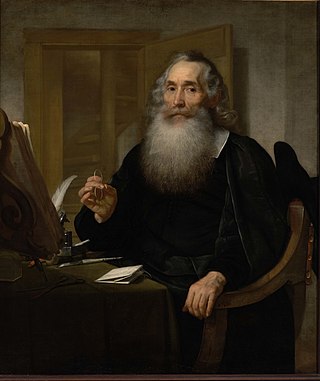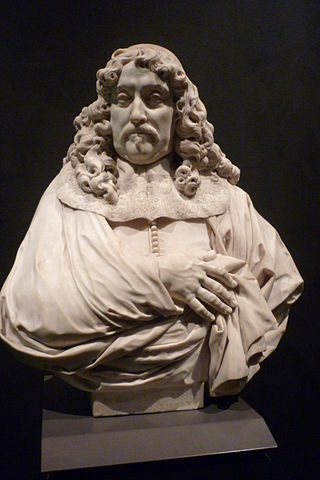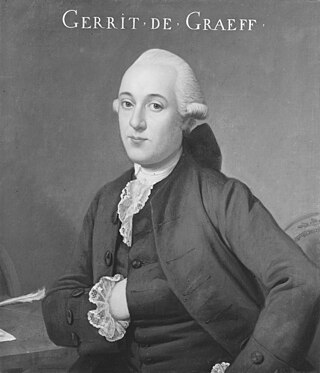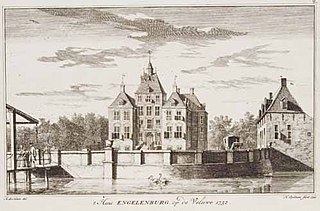
Wendela de Graeff, also called Wijntje de Graeff (Amsterdam, September 22, 1607 - there, February 27, 1652, ibid in childbirth) was a patrician of the Dutch Golden Age.

Wendela de Graeff, also called Wijntje de Graeff (Amsterdam, September 22, 1607 - there, February 27, 1652, ibid in childbirth) was a patrician of the Dutch Golden Age.
Wendela was a daughter of Amsterdam burgomaster Jacob Dircksz de Graeff of the De Graeff family and Aaltje Boelens Loen of the Boelens Loen family. [1] Wendela has a daughter, Margaretha Nooms (1632 - 1650), from a premarital relationship with Willem Nooms, lord of Aarlanderveen, whom Margaretha recognizes as her natural daughter. [2] Her baptismal record has not been found and Margaretha will undoubtedly have been baptized a Roman Catholic; in the faith of her father. The parents never got married, probably due to opposition from Wendela's family. Financial arrangements had been made for Margaretha Nooms, but the child no longer benefited from it, because it appears to have died before January 21, 1650. [3]

Wendela's first marriage in 1634 was to Pieter van Papenbroeck († 17 April 1642); [4] after his death she inherited a fortune of 439,000 guilders. [5] In 1645 she married Willem Schrijver, [4] [6] son of the philologist Petrus Scriverius [7] and Anna van der Aarund. When she remarried Willem Schrijver in 1645, Wendela de Graeff lived on the Herengracht. There her mother-in-law Elisabeth Jacobsdr Pancras, widow of Marten van Papenbroeck, had bought two adjacent houses and yards in 1644 for 38,000 guilders: the present numbers 210 and 212, close to burgomaster Cornelis de Graeff, who lived in no. 216. Six children were born from both marriages: Jacobus Martinus and Aaltje van Papenbroeck (married Gerard Bicker (I) van Swieten), Pieter (died at a young age), Anna (died at a young age), Jan and Wilhelmus Schrijver (1651-1673), married to Margaretha Six (1653-1704). [6] [8] [9]
In 1655/56 Willem commissioned Rembrandt the painting Jacob Blessing the Sons of Joseph, which depicts his father Petrus, himself (as Joseph) with his wife Wendela (as Asnath) and their two sons from her first and second marriage as biblical characters. [10] [11] Wendela de Graeff-Schrijver died in 1652 and is buried in the Oude Kerk in Amsterdam, in the Sint Cornelis choir, which was the family grave of the De Graeff family. After Wendela's death, Willem Schrijver and the Van Papenbroeck family fought for this inheritance. When Willem died in 1661, Wendela's brother Andries de Graeff took over his position. Most of the fortune went but after the appeals process to the Van Papenbroeck. [10] However, the painting from Rembrandt became the property of De Graeff.

Wendela de Graeff's coat of arms of origin was quartered and showed the following symbols:

Petrus Scriverius, the Latinised form of Peter Schrijver or Schryver, was a Dutch writer and scholar on the history of the Low Countries.

Cornelis de Graeff, often named Polsbroek or de heer van (lord) Polsbroek during his lifetime was an influential regent and burgomaster (mayor) of Amsterdam, statesman and diplomat of Holland and the Republic of the United Netherlands at the height of the Dutch Golden Age.

Catharina Pietersdr Hooft was a woman of the Dutch Golden Age. She became famous at a very early age, when she was painted by Frans Hals.

De Graeff is an old Dutch patrician and noble family,

Andries de Graeff was a regent and burgomaster (mayor) of Amsterdam and leading Dutch statesman during the Golden Age.

Dirck Jansz Graeff, also Diederik Jansz Graeff, Lord of the manors Valckeveen and Vredenhof, was a patrician, wholesaler, shipowner, politician and large landowner. He became an important figure of the Protestant Reformation, member of the Reformed Church, supporter of the Geuzen and the Protestant-minded community of wholesale merchants, and a confidant of William I of Orange. Graeff was the founder of a regent dynasty of the Dutch Golden Age and the short time of the First Stadtholderless Period that retained power and influence for centuries and produced a number of ministers. He was the first Burgomaster of Amsterdam from the De Graeff family.

Johan de Graeff, also Jan de Graeff - patrician of Amsterdam, Free Lord of Zuid-Polsbroek - was a member of the De Graeff - family from the Dutch Golden Age. His political Position was that of the Dutch States Party.

Gerrit de Graeff belonged to the patrician class of Amsterdam and held the feudal titles Free Lord of Zuid-Polsbroek as those of 21st Purmerland and Ilpendam. Known for his wealth and notorious for his stinginess, De Graeff was not particularly popular.

Gerrit de Graeff, vrijheer van Zuid-Polsbroek, Purmerland and Ilpendam was a member of the influential De Graeff family of Amsterdam. He belonged to the patrician class of the city and held the feudal titles Free Lord of Zuid-Polsbroek as those of Purmerland and Ilpendam.

Cornelis de Graeff was a member of the family De Graeff, a prominent regent family from the Dutch Golden Age. He hold the title 20st Free Lord of Purmerland and Ilpendam.

Jacob Dircksz de Graeff, free lord of Zuid-Polsbroek was an illustrious member of the Dutch patrician De Graeff family. He belonged to States Faction and was an influential Amsterdam regent and burgomaster (mayor) of the Dutch Golden Age.

KnightCornelis de Graeff was a Dutch nobleman and a water board member of the Zijpe and Haze Polder.

Jacob de Graeff was a member of the De Graeff-family from the Dutch Golden Age. He was an Amsterdam regent and held the title as 20th Free Lord of Ilpendam and Purmerland.
This is family tree of the Dutch (De) Graeff family. The House De Graeff is an alleged cadet branch of the House Von Graben that descended from the Austrian noble Wolfgang von Graben.

Cornelis Bicker van Swieten, heer (lord) van Swieten, was an Amsterdam regent of the Dutch Republic during the Golden Age and a governor of the Dutch West India Company. He was also a sugar merchant, hoogheemraad of the Hoogheemraadschap van Rijnland and a counsellor of the States of Holland and West Friesland for Amsterdam at The Hague. He belonged to the Dutch States Party and was in opposition to the House of Orange.

Jacob Bicker was a Dutch patrician and merchant. Between 1643 and 1647 he was lord of Engelenburg and a director of the Oostzeevaart, handling Dutch trade with the Baltic Sea.

The Boelens and Boelens Loen were a Dutch patrician family of Amsterdam. The family figured in the city's government lists between the years 1360 and 1680. They were considered to be quite an influential Amsterdam family in their time and were intensely involved in the history of their hometown. Between 1495 and 1538 the oligarchy of the so-called Boelen-Heijnen clan was at the forefront of the Amsterdam city government.

Cornelis Andriesz Boelens Loen was a Dutch statesman and Councilor from the time of the Dutch Revolt.

Dirk de Graeff was a Dutch 17th-century regent who belonged to the States Party.

Willem Schrijver was a Dutch patrician and politician of the Dutch Golden Age.